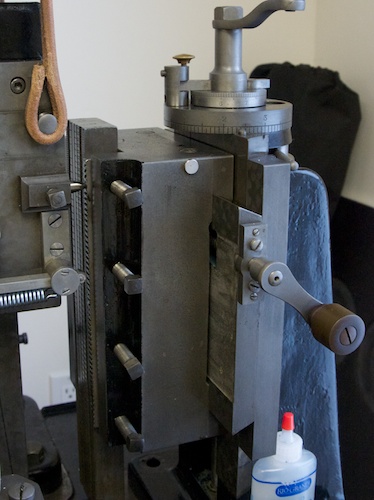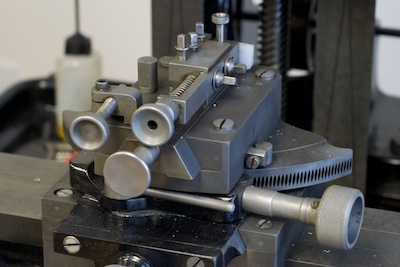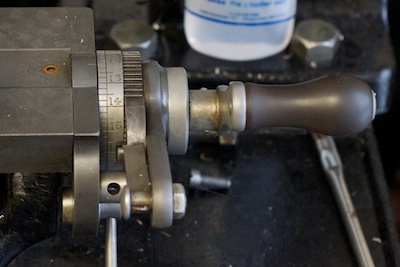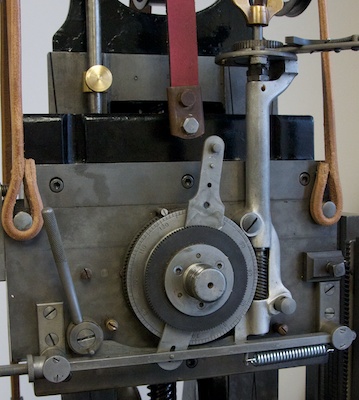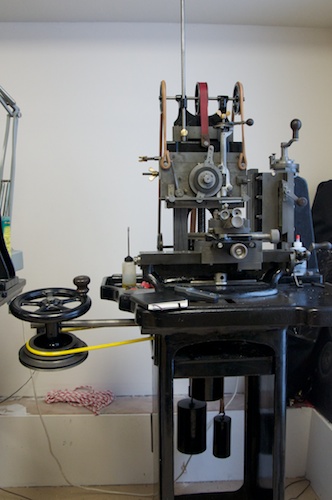In any industry, there is a cycle of new tools and gear developed. In some industries that development is slow, like the jewellery industry, in others, like photography, it is considerably faster. Whenever new tools are released, there is inevitably an explosion of rants about why the latest tool will destroy the soul of the art, or that it's the greatest thing the art has seen. The photography world in particular seems to be perfecting a masterbatory cycle of pro and anti gear rants. On one side you have "gear heads" who say you need to buy the latest and greatest thing. On the other you have the "visionaries" who say you can make great art with anything, gear be damned. I'm here to say that both are wrong.
Let's start by looking at both sides of this argument.
Gear is great. I can't argue with that. Gear is what allows me to make the things I do. I can make beautiful pens because I have a lathe. I can engine turn jewellery because I have a straight line engine. I can photograph my pieces because I own a camera and lens. I started pen turning with a small Taig lathe that I bought from Lee Valley. I paid less than $500 for it and its accessories. I made over 100 pens on it, and it certainly paid for itself as a tool to learn pen making, and enhance my skills. I could not make the pens I do today on that Taig lathe. I currently own two mid-sized metal lathes; one is a modern 10x22, the other an antique 10x28. Both are worth considerably more than the Taig I first bought. Both are considerably larger (my current lathes weight close to 1000lbs combined, while the Taig was less than 20). While both of my lathes are great, and will continue to be work horses in my shop, I'm planning on building a new one that is faster and more accurate at making certain things. It is the latest and greatest, and it will be wonderful when it arrives.
For camera gear, I currently shoot with a Nikon D300. It replaced the D70 I bought as my first SLR. It's a wonderful camera and I love shooting with it. It is has plenty of resolution, it's fast enough, and while it's over 4 years old now, it still functions properly. And I've been eagerly awaiting the new camera announcements from Nikon. Wow, hold on a second, I thought the D300 was a wonderful camera? It is, and I'll continue to use and shoot with it. But it is severly lacking in one key area, HD video. Nikon has been a little bit slower getting useful HD video support into their cameras than Canon has. The current gen Nikons, the D7000, and the recently announced D4 & D800, are the first Nikons with good enough video that I'd consider using them for that purpose. Beyond my need for HD video (I want to start shooting video of the shop and my process) I'd also like my next camera to have a full frame, 35mm, sensor in it. I don't need that, but it would be nice to have. With a larger sensor, it is easier to get wider angle shots, and also get shallower depth of field. These are things I'd like for my personal photography because they support the style of shooting I like. So at some point this year I'm hoping to buy a new camera to replace my perfectly good one.
Vision is fundamental. I've spoken about vision on this blog in the past. The difference between your kid's finger painting, and Piccaso, is artistic vision. Better quality paints or brushes or canvas won't turn your 3 year old into Piccaso. You love taking pictures of the family, but the new Nikon D4 won't turn you into Yousef Karsh.
Brenda Roy was generous to share some of her knowledge and skill in jewellery making with me years ago. She taught me the fundamentals of many of the techniques that I use every day, and pushed me towards learning new skills. The tools in my shop are worth several times those in hers. Brenda continues to produce work that far exceeds mine artistically, and will continue to despite the "lack of gear" she has access to. She has greater artistic vision than I do, and no amount of gear will help me catch up. The only way for me to do that is work harder at becoming a better artist.
So who do you listen to? The gear heads and visionaries both have good arguments. With better tools you can make things faster, more accurately, with higher resolution, but without vision it'll look like crap. With better vision, your art will be more inspiring, but with a crappy lathe the pen might not be straight, or the camera might not capture the moment. The problem is that you really need both gear and vision as an artist. The trick is figuring out the balance. Some arts rely more heavily on one than the other (better paint brushes really aren't going to help you if you can't paint). Certain techniques do require more gear; engine turning requires a straight line engine, low light photoghraphy requires a better camera.
Where do we go from here? Let's look at gear first. Several artists have been kind enough to provide me with advice on the business of being an artist. One problem that most artists face is that we don't make much money. Yes I sell expensive pens and jewellery, but I'm not going to be a millionare any time soon. I help pay the bills, but without my wife's salary, I'd have to go work for a living (while I work long hours, doing what I love really isn't that hard). So rule number one, don't put yourself into debt as an artist. If you have a regular salary coming in from a real job, you can afford to carry some debt. If you're an artist, you can't. Don't buy gear that will put you in debt.
Rule number two, borrow, rent or outsource the gear you need, for the job you need it for. If you're starting out as a jeweller, you don't need to cast your own work. There are many casting houses out there that can do it for you cheaper, and better than you can for yourself. Same thing with cameras. Don't drop $10k on buying camera gear; rent it instead. You're starting out and are shooting a friend's wedding. Renting the professional level camera body and lenses that you need is cheaper than you might think. Tell your friend that the cost of shooting their wedding is the cost of renting the gear. Now you've got something to add to your portfolio, and you didn't have to spend thousands of dollars on gear (your friend will also be happier with the photos since the pro camera and lens you rented can shoot better in available light than the consumer camera you could actually afford). If you have friends with the gear you need, offer to rent it from them. I've rented out time on my lathe to people who need a lathe, but can't afford to have one in their shop. Most camera gear sits unused in a bag most of the time. Beyond saving you money early on, there are several other benefits to renting equipment. First is that you get to use the best gear out there. Better gear does perform better. More expensive lenses are sharper and faster than cheap ones. The new D4 will take better images than a D7000 in the same circumstances. Pro tools will help make you look like a professional. Because you are renting, you can also try different tools out. Try different camera bodies, or try casting in different metals. Experimenting with different gear will allow you to figure out what you really need for the type of art you want to create. Which leads us into rule three...
Buy the best tools you can afford. Before buying gear, you need to figure out what the best type of gear is for what you're doing. That's going to take research, talking to other artists, and borrowing or renting tools. Nobody can tell you exactly what type of tools are best for executing your artistic vision. You need to figure that out on your own. But you need to be honest with yourself about what you need, don't just buy it because it's the latest and greatest (unless you have a real job and can afford to do that). Notice I didn't say buy the most expensive tools. The most expensive tool isn't necessarily the right tool for you. Yes it would be nice to have the latest and greatest of everything, but it might not be what you need. As I mentioned in the gear section, I'm looking for a replacement for my D300. Ideally I want a full frame camera, 12-18 megapixels, that can shoot 1080p30 video. The D700 has the resolution and the sensor I want, but no video. The D800 has the sensor and the video I want, but the resolution is too high (I won't go into that here, but there are disadvantages with too many megapixels). The D4 has the sensor, the video and resolution, but it is way out of my price range. So now I'm looking at the D7000 for the video I want to be able to do, and maybe a used D700 for the photography I want to do. The two cameras will likely cost the same as the D800, but they will give me all of the things I want. That's the best solution I can afford (if I could afford a D4 I'd buy it instead). It is also important not to buy cheap. You are better off renting high end tools, than buying a cheap one to hold you over. The cheap one will never do the same job, it will frustrate you, and you'll end up buying the better tool down the road anyway. If I was advising a new pen maker, I wouldn't recommend they buy the $500 Taig lathe that I did. Go out and buy the $2500 metal lathe to start. If you buy both, you'll be paying $3000 for the tool you actually need. But you also don't need to buy a $30k CNC turning center either. I can't remember where I heard this quote, and I may be paraphrasing, but poor people can't afford to buy cheap things. As an artist, you'll be poor. I can't afford to buy cheap tools. They usually slow down my work, produce inconsistent results, and break sooner than quality tools. Save up, and buy the quality tool you need. While you're saving, rent the tool you need. The quality tool will probably last you a life time of use, and is worth the wait.
How about some vision? Learning is extremely important. If you don't understand how threading works on a lathe, there is no lathe in the world that will help you. Different people learn in different ways. For some, attending a class or lecture is going to be best. For others a DVD or book will help them the most. You need to figure out what style of learning works best for you. Once you do, find the best teachers you can. Just like gear, a crappy teacher is a waste of money. Good teaching is worth the money, but not worth putting yourself into debt over. Fortunately there are more and more great teachers, and visionary artists putting their work out on the internet, and many are happy to help. As you get better as an artist, start to teach new comers to your art. Teaching is one of the best ways to improve your skills. I have a bunch of thoughts and ideas rattling around in my head on how to improve artistic vision, but that post will need to wait as they're not quite fully baked yet.
Should you keep reading the gear heads and visionaries? Sure. There is usually some nugget of information in those posts. Just understand what it is they're selling you. Visionaries will push you away from gear and technology, and towards books and lectures on how to be a better artist. Conveniently many of them are selling just that. Same thing with gear heads. Most of them have affiliate links to online stores selling camera gear etc. Of course they want you to buy the latest gear. Understand what people are selling, and take what they say with a grain of salt.
So what am I selling? I sell jewellery that most of you won't interested in. I'll hopefully start selling how to books and videos on what I make and how I make it, but again, it'll be on topics that most of you won't be interested in. I'm also selling me as an artist. I hope what I write will gather enough attention that some of you might be interested in buying my work. I'm also trying to pay it forward. I've been very fortunate to have some good friends, and talented artists give me guidance. If I'm really lucky, some of what I write will help another artist who will one day help me become better at what I do.
